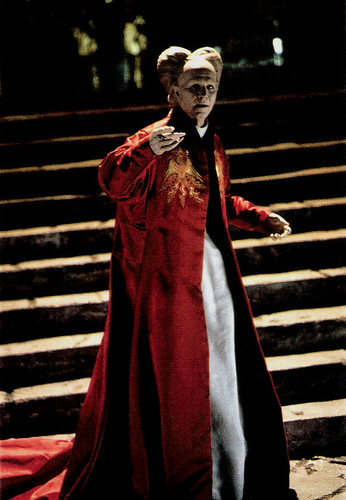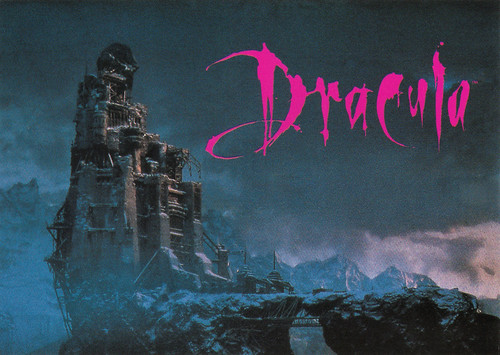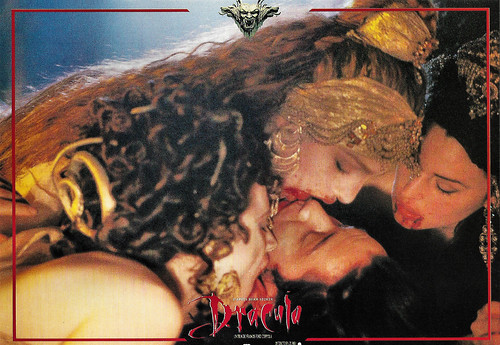Dracula (Francis Ford Coppola, 1992) or Bram Stoker's Dracula is an American gothic horror film directed and produced by Francis Ford Coppola, based on the 1897 novel Dracula by Bram Stoker. It stars Gary Oldman as Count Dracula, Winona Ryder as Mina Harker, Anthony Hopkins as Professor Abraham Van Helsing, and Keanu Reeves as Jonathan Harker. The film redefined the vampire in the cinema.

American postcard by Classico, San Francisco, no. 244-008. Photo: Columbia Pictures. Gary Oldman in Dracula (Francis Coppola, 1992).

British postcard by Heroes Publishing Ltd., London, no. SPC2581. Photo: Cary Elwes, Richard Grant, Anthony Hopkins, Keanu Reeves, and Billy Campbell in Dracula (Francis Coppola, 1992).
Dracula (Francis Coppola, 1992) is closely based on Bram Stoker's classic Gothic novel, 'Dracula' (1897).
The film opens with Count Dracula (Gary Oldman)'s vow to rise from his grave and take revenge on a God who allowed his beloved to die while he defended Him on the battlefield.
In the 1890s, Count Dracula conducts business with a London firm. When his first consultant goes mad, the young barrister Jonathan Harker (Keanu Reeves) is assigned and sent to a gloomy castle in the mists of Transylvania to arrange Dracula's real estate acquisition in London.
Harker is captured and imprisoned there by the centuries-old vampire. Count Dracula travels to London, inspired by a photograph of Harker's fiancée, Mina Murray (Winona Ryder). He believes that she is the reincarnation of Elisabeta, his long lost love.
In Britain, Dracula begins a reign of seduction and terror, draining the life of Mina's closest friend, Lucy Westenra (Sadie Frost). Lucy's friends gather together and call for Professor Van Helsing (Anthony Hopkins) to come and help. They realise that this is not a simple battle against a disease of the blood.

Dutch postcard by Film Freak Productions, Zoetermeer, no. FA 346. Photo: Columbia Pictures. Publicity still for Dracula (Francis Coppola, 1992).

Dutch postcard by Film Freak Productions, Zoetermeer, no. FA 368. Photo: Columbia Pictures. Poster for Dracula (Francis Coppola, 1992).
Francis Ford Coppola gave his Dracula (1992) rich colours in the scenery and elaborate costumes that bring the goth out of the film. Coppola chose to invest a significant amount of the budget in costumes in order to showcase the actors, whom he considered the "jewels" of the feature.
Coppola and his team also worked well with shadows and backlighting. This gave the film the feel of an old silent film but with modern standards, thanks to some wild but excellent special effects.
The film's hair and makeup designer, Michèle Burke, cited at Wikipedia: "Francis didn't want the typical Dracula that had already been done in Hollywood. He wanted something different; a new Dracula without the widow's peak, cape, or pale-white skin."
The costume design by Eiko Ishioka created a new image for the Count and freed him for the first time from the black cape and evening wear. Dracula had become associated with the cape since Bela Lugosi's portrayal in Dracula (Tod Browning, 1931).
Wojciech Kilar composed a score that is haunting but romantic as well.
And Gary Oldman made a very memorable Dracula. His performance is ranging from creepy and disturbing to romantic and charming. However, there are also scenes in the film that are over the top and overacted.

Dutch postcard by Film Freak Productions, Zoetermeer, no. FA 344, 1992. Photo: Columbia Pictures. Keanu Reeves, Michaela Bercu, Monica Bellucci, and Florina Kendrick in Dracula (Francis Coppola, 1992).

French postcard by Sonis, no. C. 322. Photo: Columbia Pictures. Keanu Reeves, Michaela Bercu, Monica Bellucci, and Florina Kendrick in Dracula (Francis Coppola, 1992).
Dracula (Francis Ford Coppola, 1992) was theatrically released in the United States to positive reviews. Americamn critic Roger Ebert: "I enjoyed the movie simply for the way it looked and felt. Production designers Dante Ferretti and Thomas Sanders have outdone themselves. The cinematographer, Michael Ballhaus, gets into the spirit so completely he always seems to light with shadows."
The film grossed $215 million against a production budget of $40 million. It was nominated for four Academy Awards and won three for Best Costume Design, Best Sound Editing, and Best Makeup.
The closing credits theme 'Love Song for a Vampire', which was written and performed by Annie Lennox, became an international success.
Dracula (Francis Ford Coppola, 1992) is now seen as a game-changer, which established a tone and style that redefined cinematic vampires. Francis Ford Coppola and his crew created a host of new vampire film tropes, like retractable fangs, vampires turning into literal bat-men, and a steampunk aesthetic.
The film was ranked as the best vampire film ever in Forbes' "Top 10 Best Vampire Movies Of All Time" list. The film was also included in Entertainment Weekly's "5 best vampire movies", Esquire's "20 Best Vampire Movies" and "Sexiest Horror Movies Ever Made", IndieWire's "The 100 Best Horror Movies of All Time" and "The 12 Best Vampire Movies Ever Made".
Official trailer Dracula (1992). Source: TrailersPlaygroundHD (YouTube).
Sources: Wikipedia and IMDb.

American postcard by Classico, San Francisco, no. 244-008. Photo: Columbia Pictures. Gary Oldman in Dracula (Francis Coppola, 1992).

British postcard by Heroes Publishing Ltd., London, no. SPC2581. Photo: Cary Elwes, Richard Grant, Anthony Hopkins, Keanu Reeves, and Billy Campbell in Dracula (Francis Coppola, 1992).
Dracula's Revenge
Dracula (Francis Coppola, 1992) is closely based on Bram Stoker's classic Gothic novel, 'Dracula' (1897).
The film opens with Count Dracula (Gary Oldman)'s vow to rise from his grave and take revenge on a God who allowed his beloved to die while he defended Him on the battlefield.
In the 1890s, Count Dracula conducts business with a London firm. When his first consultant goes mad, the young barrister Jonathan Harker (Keanu Reeves) is assigned and sent to a gloomy castle in the mists of Transylvania to arrange Dracula's real estate acquisition in London.
Harker is captured and imprisoned there by the centuries-old vampire. Count Dracula travels to London, inspired by a photograph of Harker's fiancée, Mina Murray (Winona Ryder). He believes that she is the reincarnation of Elisabeta, his long lost love.
In Britain, Dracula begins a reign of seduction and terror, draining the life of Mina's closest friend, Lucy Westenra (Sadie Frost). Lucy's friends gather together and call for Professor Van Helsing (Anthony Hopkins) to come and help. They realise that this is not a simple battle against a disease of the blood.

Dutch postcard by Film Freak Productions, Zoetermeer, no. FA 346. Photo: Columbia Pictures. Publicity still for Dracula (Francis Coppola, 1992).

Dutch postcard by Film Freak Productions, Zoetermeer, no. FA 368. Photo: Columbia Pictures. Poster for Dracula (Francis Coppola, 1992).
No black cape and evening wear
Francis Ford Coppola gave his Dracula (1992) rich colours in the scenery and elaborate costumes that bring the goth out of the film. Coppola chose to invest a significant amount of the budget in costumes in order to showcase the actors, whom he considered the "jewels" of the feature.
Coppola and his team also worked well with shadows and backlighting. This gave the film the feel of an old silent film but with modern standards, thanks to some wild but excellent special effects.
The film's hair and makeup designer, Michèle Burke, cited at Wikipedia: "Francis didn't want the typical Dracula that had already been done in Hollywood. He wanted something different; a new Dracula without the widow's peak, cape, or pale-white skin."
The costume design by Eiko Ishioka created a new image for the Count and freed him for the first time from the black cape and evening wear. Dracula had become associated with the cape since Bela Lugosi's portrayal in Dracula (Tod Browning, 1931).
Wojciech Kilar composed a score that is haunting but romantic as well.
And Gary Oldman made a very memorable Dracula. His performance is ranging from creepy and disturbing to romantic and charming. However, there are also scenes in the film that are over the top and overacted.

Dutch postcard by Film Freak Productions, Zoetermeer, no. FA 344, 1992. Photo: Columbia Pictures. Keanu Reeves, Michaela Bercu, Monica Bellucci, and Florina Kendrick in Dracula (Francis Coppola, 1992).

French postcard by Sonis, no. C. 322. Photo: Columbia Pictures. Keanu Reeves, Michaela Bercu, Monica Bellucci, and Florina Kendrick in Dracula (Francis Coppola, 1992).
A gamechanger that redefined the cinematic vampire
Dracula (Francis Ford Coppola, 1992) was theatrically released in the United States to positive reviews. Americamn critic Roger Ebert: "I enjoyed the movie simply for the way it looked and felt. Production designers Dante Ferretti and Thomas Sanders have outdone themselves. The cinematographer, Michael Ballhaus, gets into the spirit so completely he always seems to light with shadows."
The film grossed $215 million against a production budget of $40 million. It was nominated for four Academy Awards and won three for Best Costume Design, Best Sound Editing, and Best Makeup.
The closing credits theme 'Love Song for a Vampire', which was written and performed by Annie Lennox, became an international success.
Dracula (Francis Ford Coppola, 1992) is now seen as a game-changer, which established a tone and style that redefined cinematic vampires. Francis Ford Coppola and his crew created a host of new vampire film tropes, like retractable fangs, vampires turning into literal bat-men, and a steampunk aesthetic.
The film was ranked as the best vampire film ever in Forbes' "Top 10 Best Vampire Movies Of All Time" list. The film was also included in Entertainment Weekly's "5 best vampire movies", Esquire's "20 Best Vampire Movies" and "Sexiest Horror Movies Ever Made", IndieWire's "The 100 Best Horror Movies of All Time" and "The 12 Best Vampire Movies Ever Made".
Official trailer Dracula (1992). Source: TrailersPlaygroundHD (YouTube).
Sources: Wikipedia and IMDb.
No comments:
Post a Comment